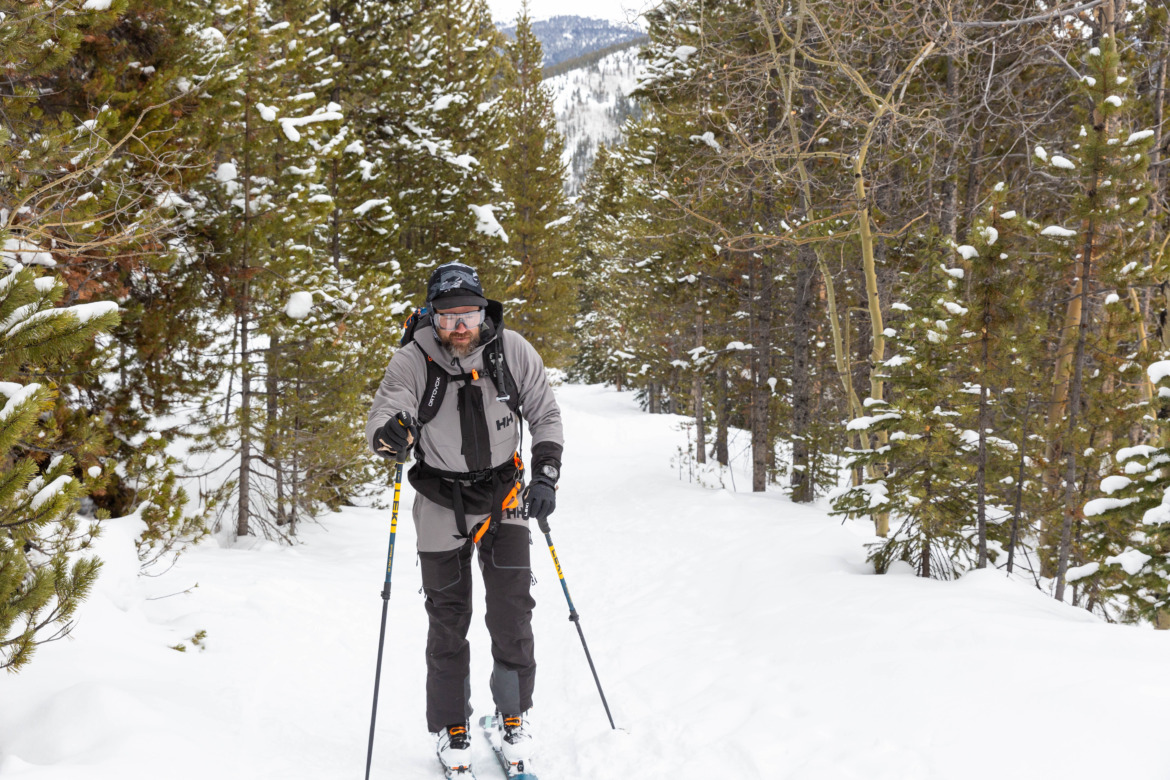
I’ve long been a shell guy when it comes to outerwear for ski touring but as I’ve picked up my pace on uphills and toured longer and longer into spring and summer, I’ve found myself searching for lighter layers that don’t immediately turn into a sauna.
No matter what marketing copy might say about the breathability of Gore-Tex and competitor membranes, they are simply too much for high-output touring (for me, anyway) in anything above about 25 degrees, no matter how big the ventilation zips are.
So I jumped on the chance to test an early prototype of Helly Hansen’s Odin BC Softshell Bib and Softshell Jacket combo last spring and I’ve continued wearing it throughout the season this year. I was excited in part because I was generally “softshell-curious” but also because I had yet to find a softshell bib and, well, I’m a bib guy. Lots of companies are making backcountry outerwear these days, but it’s mostly lightweight versions of resort gear with beacon storage. Thankfully, Helly Hansen didn’t bother with another “me too” release and this is the only kit I’ve seen with a softshell bib.
What I’ve found (somewhat to my surprise) after 30-plus days touring in the kit in all kinds of conditions is that while they’re not markedly more breathable, there aren’t many drawbacks to the softshell construction as compared to my trusty 3-layer shells and there are several advantages that have me reaching for the Odin BC Softshell kit as my new go-to touring outerwear.
Specs & Features
- PFC-free DWR
- 3 different shell materials, body-mapped
- Elastic wrist cuffs
- Articulated sleeves and knees
- D-ring for beacon pocket carry in bibs
- Beacon access pocket in jacket (for harness carry)
- Boot gaiters and boot cuff zips
- RECCO reflectors
- Side ventilation zips on bibs
- Weights (measured): Jacket (574g), Bibs (817g)
- Cost: Jacket ($280 at Backcountry), Bibs ($320 at Evo)

Grid fleece-backed softshell transitions to a more durable single layer above the wrist on Helly Hansen’s Odin BC Softshell Jacket
Construction
While Helly Hansen accurately describes the jacket and bib trousers as “softshell”, they’re not exactly a traditional softshell which I think of as a thicker, singular layer of spongy polyester or nylon with DWR. Both bib and jacket use three different materials in a body-mapped patchwork.
The slate-gray patches are a four-way stretch material made up of polyester, polyamide, and elastane that goes heavy (10%) on the elastane for stretch. The face is as durable as a light 3-layer shell but there’s a thin grid fleece on the inside for keeping back, back of legs, and stomach warmer.
A thin strip of a different black fabric runs under the arm almost all the way from wrist through armpit to waist and it’s a very thin and even stretchier (24% elastane) blend of the same materials that maximizes mobility and breathability. The same fabric appears at the top of the bib for the same reasons.
The third (also black) fabric is the least stretchy (7% elastane) but still more forgiving than 3-layer that makes up most of the black patches on both bib and jacket. It’s a bit more stiff and durable and comprises the higher-wear areas at the bottom of the jacket below the waist, the sleeve cuffs, parts of the hood, and most of the legs of the bibs from above the knee on down. Below the calf, the seams are taped but elsewhere are mostly not. The insides of the boot cuffs are reinforced with a rubberized coating.
After 30-plus days of touring, the durability seems trustworthy as the kit looks like new and I’ve had no issues with zippers (other than a lost pull described below) and the fabrics have endured frequent run-ins with tree branches punching through tight sections of trees. Unlike my lighter-colored 3L outerwear, the light gray fabric hasn’t attracted stains from bumping up against my filthy truck.
Overall, the build is streamlined. Zippers are light gauge and pockets are backed by a thin mesh, so both garments pack down about as small as a lightweight shell. Because they have less of the bulkier grid fleece, the bibs actually pack down nearly as small as the jacket. There’s no packability advantage over a lightweight shell here, but they’re certainly less stiff so you can shove them in around other items in a pack a bit more easily.
The jacket weighed in at 574g and the bibs 817g. For context, my ultralight Trew Capow jacket and bibs weigh 611 and 927 grams, respectively. Other shell bibs in this category: Picture Organic Lassen Xpore 3L Bibs: 667g, Outdoor Research SkyTour AscentShell Bibs: 794g. The weights and packed sizes fall in the range of touring-oriented shell outerwear, so the comparison is mostly a wash on that metric.
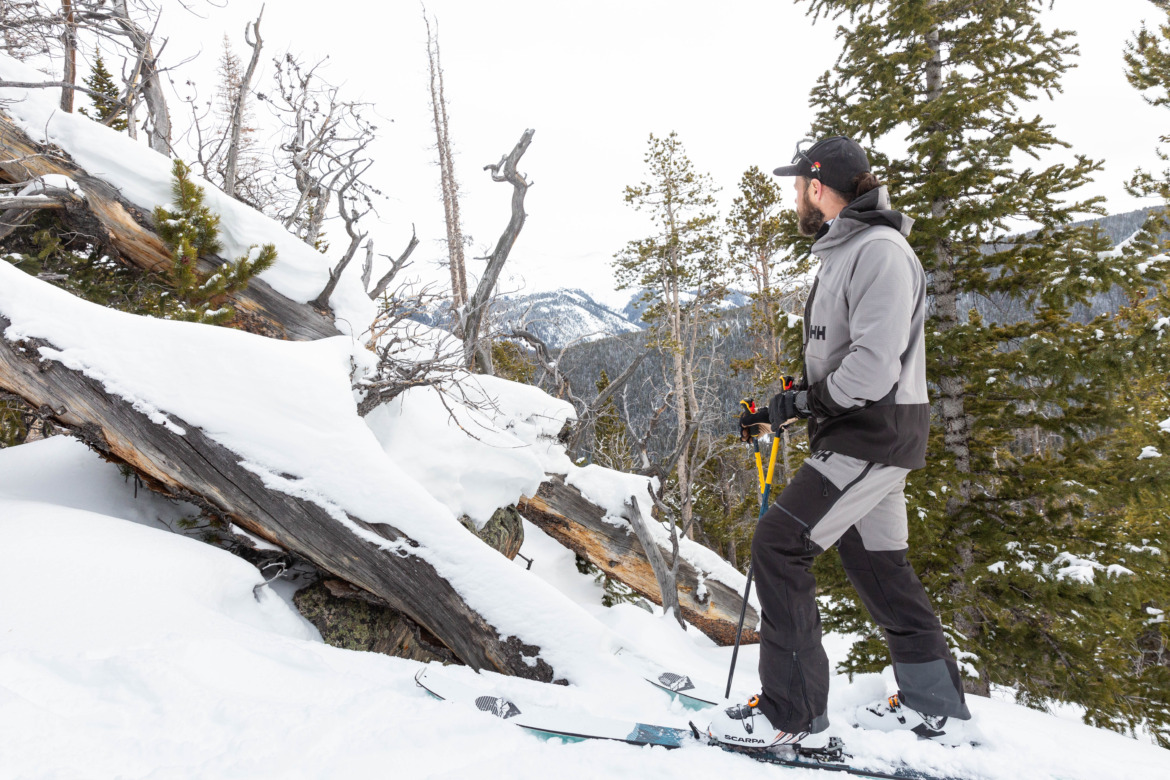
Performance
The combination of fabrics makes me think of the Odin kit more as a hybrid of softshell and thin non-membrane shell than wholly a traditional softshell. All three fabrics do a decent job of blocking wind and shucking off light moisture, but the grid fleece-backed gray sections are noticeably warmer and Helly Hansen did a great job placing them where you’d be more likely to feel the cold: around the chest, neck, back of the arms, waist, and back of the thighs.
I’ve heard it stated like a law of nature that softshells are more breathable than hardshells, but I run hot generally and if I’m running hot enough to steam out an ultralight touring-oriented 3-layer jacket, I’m going to do the same in the Odin BC Softshell Jacket. The looser fit helps, but there are no pit zips here, so if temps and sun exposure dictate, sometimes the jacket has to come off. On warmer days about 25 degrees and up, I start with the jacket in the pack just as I would with a shell and only pull it out on windy ridges and for the descent. Likewise, the bibs are light, but the grid fleece sections hold body heat which is great on cold days but has me lunging for the side zips on warmer days.
So why go softshell if it’s not substantially more breathable? For me, it’s the comfort and flexibility compared to stiffer softshells. While I have 3-layer shell bibs and jackets (Trew Capow are my favorites) that are ultralight and much softer than a resort-oriented Gore-Tex Pro shell, they still can’t compare to the softness and stretch of the Odin BC Softshell kit. The flipside here is that if you like lightweight shells and are looking at the Odin for big breathability improvements, look elsewhere.
I’ve never felt consciously restricted wearing shell outerwear in the backcountry, but when switching to the Odin kit, the instant feeling of freedom of movement was palpable and it’s the main reason I reach for it anytime conditions permit.
Speaking of conditions, it’s worth noting that I ski mostly above 10,000 feet in the Colorado Rockies where snow falls light and dry and spring rain is rarely more than a light spritzing. While 3-layer shells work great throughout the winter for stopping wind and shedding snow, they’re not as essential as in wetter, warmer regions. In more than 30 days touring in the Odin kit in winter and spring, I never felt the limitations of the weatherproofing, but I switch to a 3L shell if nasty weather threatens, and your experience may be different depending on where you tour.

The Odin BC Softshell Jacket and Bibs look and feel like a uniform. Or tracksuit?
Fit & Aesthetics
The cut of the jacket is refreshingly ski shell-like. My gripe with other softshell jackets and touring shells I’ve tested is they’re often a slim fit and a shorter length that seems better suited to hiking than skiing. The Odin BC Softshell Jacket hangs well below the waist so there’s no concern of the jacket sneaking out above the hip belt of your pack.
Compared to any other shell bibs I’ve tested, the bib fit is more tailored but not nearly as snug as most softshell touring pants from the European brands such as La Sportiva or Ortovox. If you’re used to a baggier shell pant or bib, the crotch will feel high, but I found that the material is stretchy enough that I never feel constricted by it and it’s actually welcome when touring since fabric isn’t bunching or creating unnecessary friction on every stride.
While the Odin BC Softshell Bib Trousers are definitely bibs, they don’t reach as high as most, stopping a few inches above my bellybutton and they fall somewhere between a full overall-style bib and pants with suspenders. I sometimes miss the chest pocket found on most taller bibs, but the lower cut helps with overheating while still avoiding the conflagration of materials at the waist I loathe when wearing ski pants with a belt at the same height as my baselayer waist, underwear, and pack hip belt.
In terms of looks, this is definitely a kit in the European spirit of color-coordinated top and bottom. As mentioned, the jacket is a more North American tailoring, but the snugger bibs will be a departure for those used to the normally baggy cut of most shell-style ski bibs. The first time I wore the Odin BC Softshell kit with a regular touring partner, he deadpanned, “You look fast.”
I personally like the almost tracksuit-like aesthetic and I actually feel like I should be going faster uphill wearing it than when I’m in a Gore-Tex shell combo that’s obviously just along for the descent. However, in the broader landscape of softshell touring options, it’s much less skimo than most.
If you like the coordinated kit theme and want more options, Helly Hansen also makes a shell jacket and pants (no shell bibs) in the same colorways in the Odin BC line as well as a matching active insulation Insulator jacket that can be worn alone or as a midlayer under the shell or softshell.
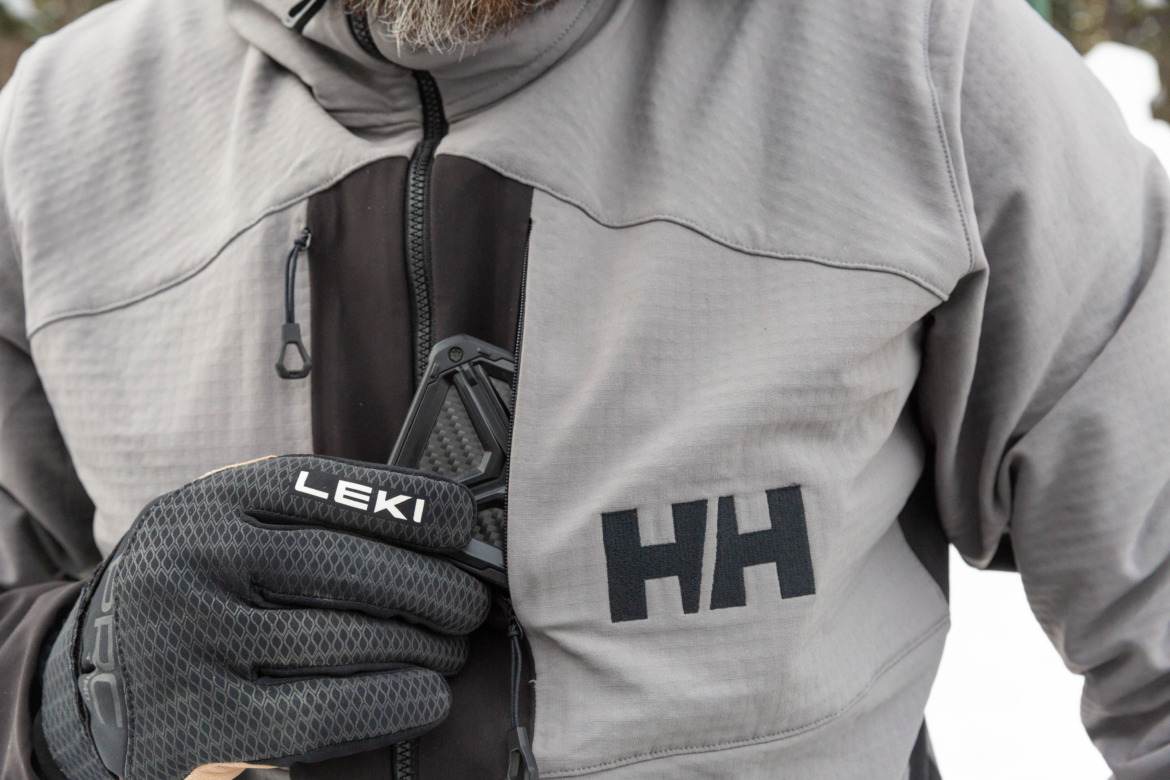
Double chest pockets on the Odin BC Softshell Jacket.
Pockets & Features
There are a few backcountry-specific design cues here, led by beacon storage and access options. On the bibs, there’s a thigh pocket with D-ring for pocket carrying a beacon, much to the dismay of many Europeans, though it’s primarily where I store mine in avalanche terrain when wearing the Odin BC kit.
If you harness-carry your beacon, there’s a pass-through zipper opening below the chest on the jacket for easy access. My only gripe with your options here is that if you store your beacon in the dedicated thigh pocket and take the jacket off, it can be difficult to maintain the recommended 20cm of distance between phone and transceiver using just the pockets available in the bibs.
There are two zippered hand pockets on the bibs about where you’d find them on a pair of jeans which are great for keeping smaller items like lip balm away from your knees. Outside of the beacon-access pocket, the jacket keeps it simple with two mesh-backed chest pockets accessible while wearing a pack and a small mesh net pocket on the inside of the jacket for stashing a beanie or gloves.

D-ring inside thigh pocket for heathens that pocket carry their beacon.
If I could make one tweak to this layout it would be to create a place to hold skins if you’re moving quickly and don’t want to take your pack off. Sure, you can just stuff the skins inside the jacket and let your pack’s hip strap keep them from sliding out, but more than once, I’ve done that and had my skins fall out when I took off my hip belt when stopped. Adding another inside mesh pocket and making them a bit larger wouldn’t add much material or weight and it would at least give you the option to have a dedicated stash for skins.
The most robust zippers in the whole kit appear on the outside of the thighs in the form of substantial ventilation openings and thankfully they’re easy enough to operate with one hand so you can throw them open without breaking stride. Sadly, there’s no corollary on the jacket and I’d deal with a little extra bulk to have the option when I’m on the fence about needing to remove the jacket entirely.
Most of the zipper pulls come with plastic tabs so they’re easier to operate with gloves and so they don’t inevitably untie and fall off like most string-only pulls. Oddly the fly zipper doesn’t have a tab and mine disappeared in the first few weeks of use. Easy enough to make a new one with paracord (gently melt the knot to avoid repeating the loss), but I’d take a plastic tab there in the future.
It’s worth a nod to the elastic sleeve cuffs on the jacket which stay roomy down to the wrist and can be pulled over gloves or clamped underneath a gauntlet cuff. Many other touring jackets I’ve tested have no cuff adjustment or elastic at all which leave you with an annoying gap for wind, or if they do have adjustment it’s often frustratingly narrow as if they borrowed the dimensions from a running windbreaker.
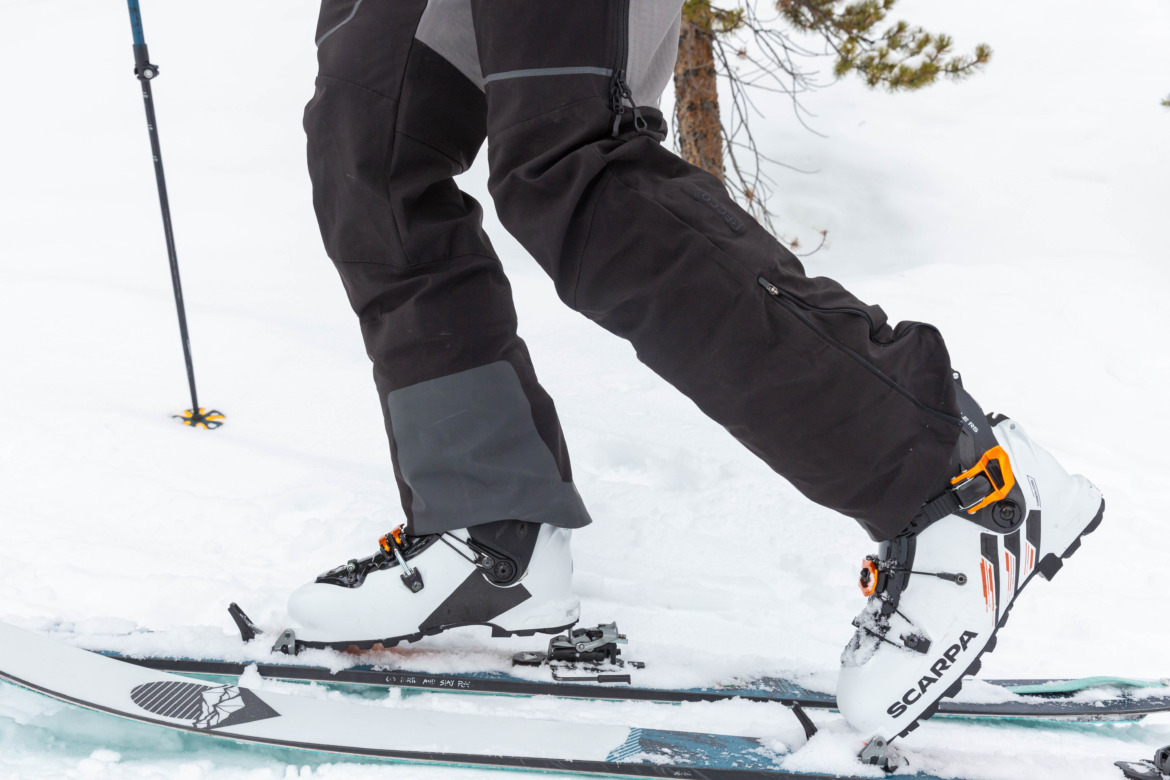
Rubberized gaiter reinforcement on the inside, zippered expansion for uphilling on the outside.
Bottom Line
I first donned the Odin BC Softshell kit hoping to find a maximally breathable warm-weather outerwear solution, but ended up loving it for much different reasons. While I found the breathability improvements over an ultralight 3-layer shell minimal, the comfort and stretch are what keep me coming back on all but the coldest days in the backcountry.
This kit is a more comfortable alternative to stiffer shell outerwear for folks who are happy to trade off some weather resistance for a quieter, more comfortable, and more mobile outfit. But if you’re a high-output racer type looking for something with drastically better breathability than shells, keep looking.
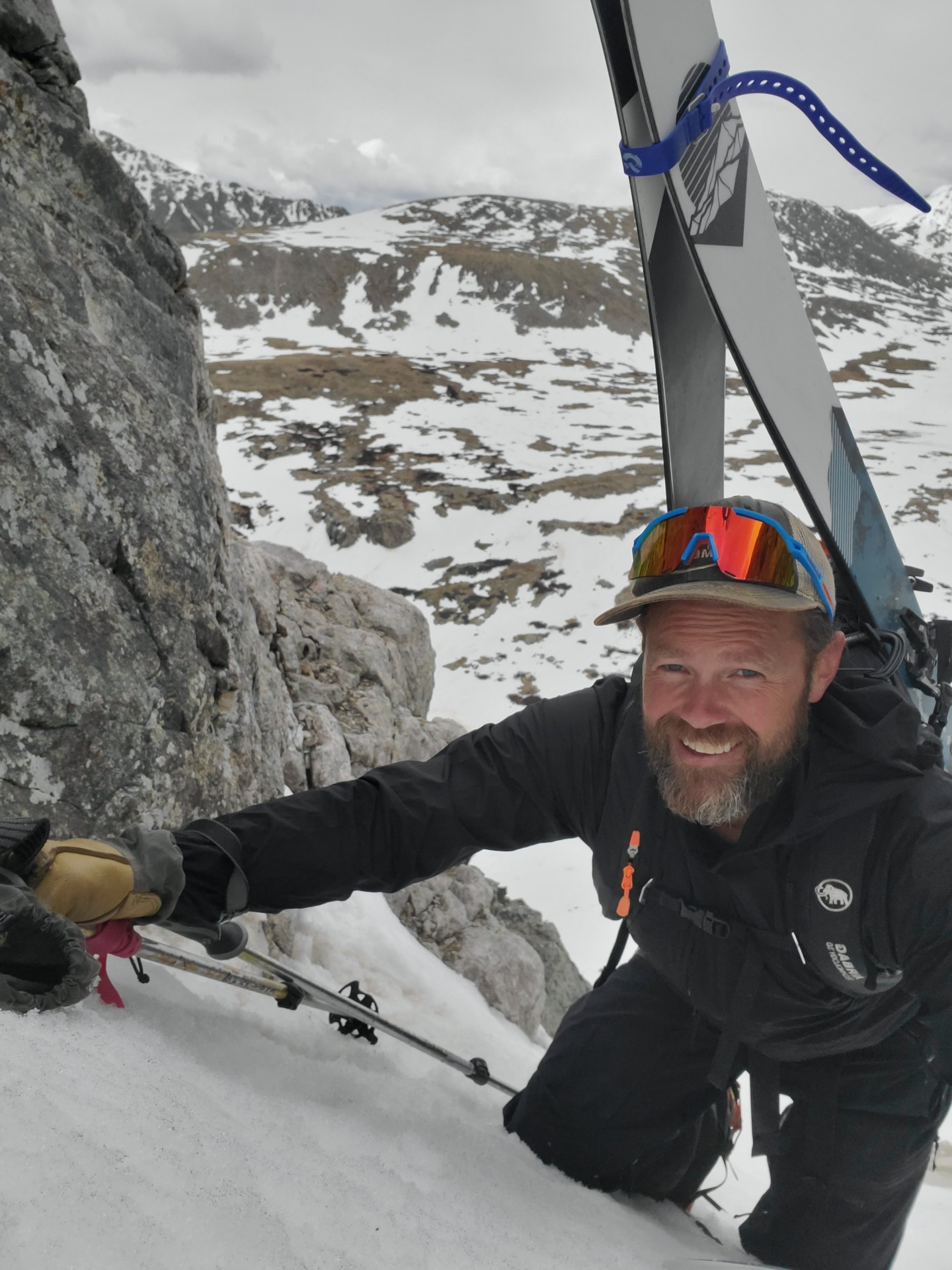
Justin Park is the Editor of Wild Snow. In 2009 while living in Hawaii, he got invited on a hut trip in Colorado. He had no backcountry gear, found Wild Snow, read up on backcountry skiing and bought some frame bindings for a pair of G3 Reverends so he didn’t have to buy touring boots. He moved to Breckenridge, CO a year later and today he skis 100+ days a year, most of them backcountry.
